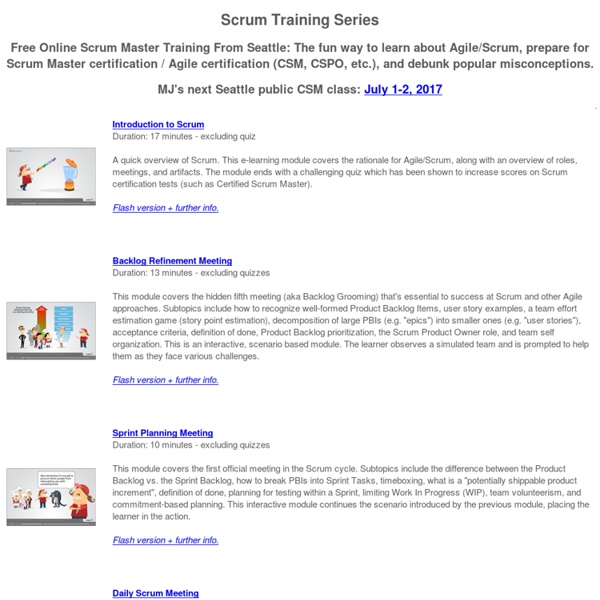



Scrum Reference Card | Scrum Reference Card Print version A Management Framework Scrum is a management framework for incremental product development using one or more cross-functional, self-organizing teams of about seven people each. It provides a structure of roles, meetings, rules, and artifacts. Scrum uses fixed-length iterations, called Sprints, which are typically 1-2 weeks long (never more than 30 days). An Alternative to Waterfall Scrum’s incremental, iterative approach trades the traditional phases of “waterfall” development for the ability to develop a subset of high-value features first, incorporating feedback sooner. Figure 1. Figure 2: Scrum blends all development activities into each iteration, adapting to discovered realities at fixed intervals. The greatest potential benefit of Scrum is for complex work involving knowledge creation and collaboration, such as new product development. Doing Scrum, or Pretending to Do Scrum? Product Owner Scrum Development Team ScrumMaster Figure 3: Scrum flow Sprint Planning Meeting Lean
Writing Good User Stories Over the last few weeks, I’ve written alot about writing good User Stories – you can see them all here: User Stories. User Stories are a simple way of capturing user requirements throughout a project – an alternative to writing lengthy requirements specifications all up-front. As a guide for people writing User Stories, they can follow this basic construct: As a [user role], I want to [goal], so I can [reason]. This helps to ensure that the requirement is captured at a high level, is feature oriented and covers who, what and why. As well as capturing User Stories in the above format on the Product Backlog, User Stories should be written on a card. The card comprises 3 parts: Card (i.e. the bit above, “as a user, I want…”)Conversation (notes and/or small wireframe to remind people about the feature)Confirmation (the tests that will show the feature is complete) Here’s an example User Story for you to take a look at. Ultimately, User Stories should be small. * Independent. * Negotiable. * Small.
7 Obstacles to Enterprise Agility | Scrum Reference Card Print version I work with divisions of large companies that are struggling to become agile, starting with Scrum. While each organization is in a distinct business sector using different technology and management cultures, each one shares a common pathology, a kind of “giantism.” This article lists common obstacles to agility in large organizations and explores the possibility that the symptoms of giantism are entirely avoidable. At first glance, an organization’s challenges will appear to be “too much to do” or “not enough resources” or “changing business climate.” A division of a well-known company cited as a 1997 success story by a famous Scrum pioneer came to Danube Technologies, Inc. for help in 2009 because market forces revealed it was less agile than its competitors. Obstacle #1: Naive Resource Management The PMBOK Guide observes “often the budget needs to be increased to add additional resources to complete the same amount of work in less time.” Obstacle #4: Distraction
User Story Examples and Counterexamples | blogs.collab.netblogs.collab.net People who share my background in traditional requirements analysis often have a hard time coming up with Product Backlog Items representing thin vertical slices of potentially-shippable product. Here are some good and bad examples that people have found useful. User Stories may assume template form (see User Stories Applied by Mike Cohn): “As a [role] I can [function] so that [rationale].” or expressed as noun phrase: “Image clipboard” or a 1-2 sentence story (ideally a testable assertion): “Busy streets are highlighted on the map.” User stories, like all Product Backlog Items, should contain or clearly imply acceptance criteria (definition of “done”). Bill Wake has given us the INVEST mnemonic to help remember the characteristics of a well-formed user story: I – IndependentN – NegotiableV – ValuableE – EstimableS – SmallT – Testable What does this look like in practice? A bank customer can change his PIN. How do we know when we’re missing the mark? “Design brochure layout.”
Basecamp is everyone’s favorite project management app. The Scrum Factory Green Screen Software | Free Photoshop Plugin » [Tool Review] – ScrumDo – Free and Sweet Open Source Scrum [We review Agile tools. Have you seen our Agile tools list?] “Isn’t it time that everyone benefitted from the time-tested Agile methodologies without the cost of training and expensive ‘experts?’” – Peter Saddington“Over here at ScrumDo, we totally agree with you. Most of the tools out there are stupid-expensive or they don’t make it easy enough to succeed with scrum. It’s one of the reasons we decided to make our software open source and free for everyone.” – Marc Hughs (Developer at ScrumDo.com) We’re all about free open source lean tools that just work. [Enter]: ScrumDo – The Open Source Scrum tool with powerful results When you get started you’ll be greeted with a couple of options: Create a new project or create a new organization. After you’ve created your organization you can move onto creating a project. For our purposes, we added 4 stories and moved on to the next step: Iteration planning. Check out your backlog and you have 4 options to choose from: Overall project status?